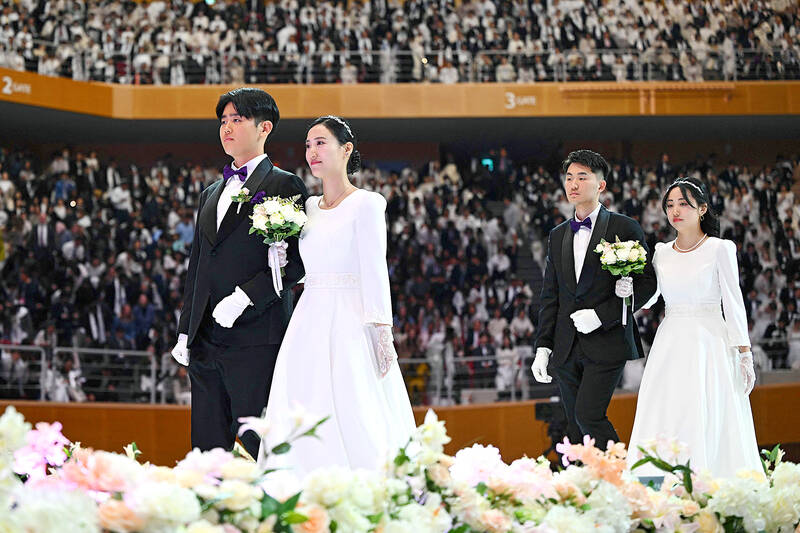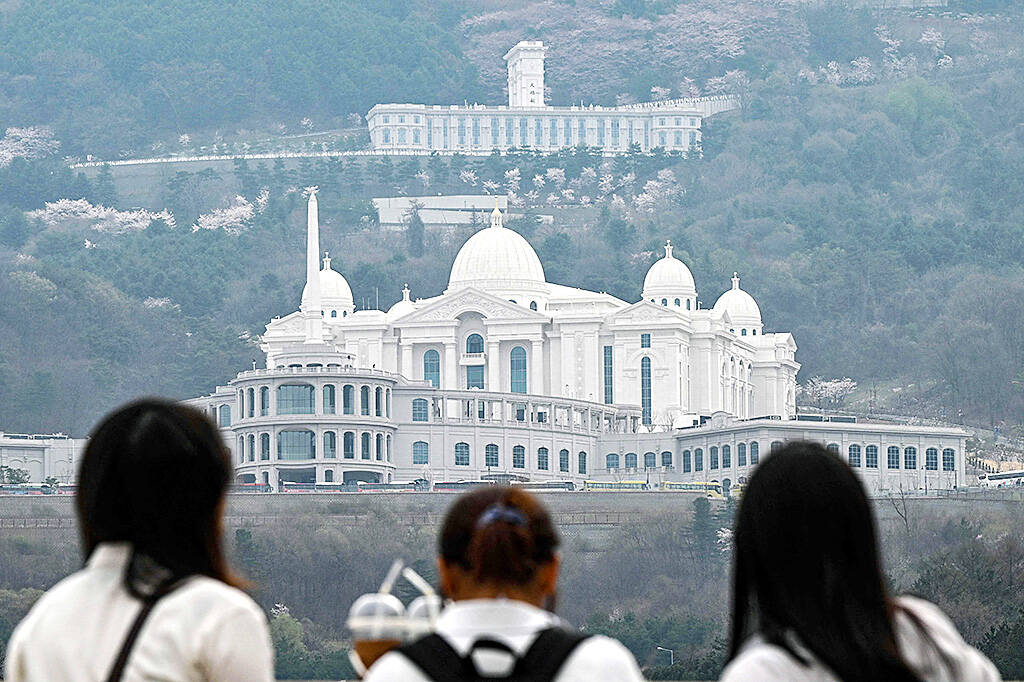They’ve been called a cult, accused of coercive fundraising, and legally disbanded in Japan. But in a mountainous town nestled in South Korea, thousands of “Moonies” gathered this month for a mass wedding.
Around 1,300 couples from dozens of countries tied the knot at the Unification Church’s sprawling headquarters in Gapyeong, north of Seoul, under the supervision of their controversial leader, known as the “holy mother.”
The spectacular tradition, which dates back to the first so-called “blessing ceremony” featuring 36 couples in 1961, is an integral part of the broadly neo-Christian beliefs held by the church, founded by Moon Sun-myung and now run by his widow, Han Hak-ja.

Photo: AFP
The church claims these mass weddings can help reverse South Korea’s woeful birthrate, improve family values, and ultimately bring about Moon’s goal of completing the unfulfilled mission of Jesus Christ to restore humanity to a state of “sinless” purity.
“I’m just really grateful,” American Emmanuel Muyongo, 29, said at the ceremony, where he married his Japanese wife, whom he met years ago and grew close to at a church in the US.
Muyongo’s own parents married at a mass wedding, and he said that he was honored “to experience what my parents’ experienced.”

Photo: AFP
“We love you, Holy Mother Han!” the couples shouted in unison at one point during the event, which featured blaring fanfare and confetti cannons.
Han, 82, looked almost eerily calm throughout the festivities, once slowly waving at her excited followers while wearing sunglasses and a green dress.
‘HOLY MOTHER’

Photo: AFP
The church, which was founded in 1954, claims to have around three million followers globally — including 300,000 in South Korea, 600,000 in Japan — and oversees a sprawling business empire encompassing construction, tourism, education and media, among others.
But in Japan, the church has been accused of coercive fundraising, especially after the 2022 assassination of former prime minister Shinzo Abe, allegedly carried out by a man who harbored resentment toward the sect. A court there revoked its legal status as an organization last month, although its members can continue to meet.
Abe’s accused killer blamed the church for his family’s financial ruin, after his mother made huge donations. Abe — along with other world leaders including US President Donald Trump — had sent video messages to events linked to the church.
But at the mass wedding this month, followers were unfazed by the recent legal blow, with the visibly emotional couples — including Japanese — radiating joy and gratitude to Han.
After Moon’s 2012 death, Han stepped up to lead the church and is now referred to by members as god’s “only begotten daughter” and the “holy mother.”
The church has links to everything from a major South Korean newspaper to a high-end ski resort used for the 2018 Pyeongchang Winter Olympics. It is also affiliated with esteemed art institutes.
In 1991, Han joined her late husband — revered by followers as a messiah but dismissed by critics as a charlatan — on his trip to North Korea to meet with its founder, Kim Il-sung, to discuss the reunification of the divided peninsula.
When her husband died, North Korea’s current leader Kim Jong-un sent a personal message of condolence. He later presented her with a pair of North Korean Pungsan dogs, a token of his goodwill.
This week, South Korean media alleged that the church had bribed former first lady Kim Keon-Hee — whose husband, Yoon Suk-Yeol, was recently ousted over his declaration of martial law — with a diamond necklace worth around US$41,970.
INDEMNITY
The church has appealed the Japanese court’s decision. Experts say that Japan, Korea’s former colonial ruler, has long been a financial hub for the sect.
“Usually, religious businesses like Unification Church target isolated lower-middle class individuals,” said Vladimir Tikhonov, Korean Studies professor at the University of Oslo.
“Their main ‘hunting ground’ is not South Korea, it is actually Japan,” he added.
Since the 1960s, the church is believed to have generated as much as 80 percent of its global revenues from Japan, according to Levi McLaughlin, a religious studies professor at North Carolina State University.
During Japan’s 1980s bubble economy, its branch reportedly sent up to 10 billion yen (US$70 million) per month to the South Korean headquarters.
Japanese followers are told to “atone” for the country’s colonial past, and McLaughlin said the mass weddings have been framed as a form of “indemnity.”
The church plays a role in match-making couples, experts say, with Japanese women often matched with non-Japanese men — and critics slam the cult-like cutting of family ties that sometimes results.
But this month in Gapyeong, more than 1,000 couples — each bride in near-identical white gowns and modest tiaras — wiped away tears, held hands tightly, and swayed to music as they danced and took selfies.
The couples “started from happiness and love, but it seems that those who don’t understand it well are misinterpreting it and only seeing the negative aspects,” said Remi Kosuga, 27, one of the brides.
“We simply want to believe in and learn about love. ... I hope people can see that.”

In the March 9 edition of the Taipei Times a piece by Ninon Godefroy ran with the headine “The quiet, gentle rhythm of Taiwan.” It started with the line “Taiwan is a small, humble place. There is no Eiffel Tower, no pyramids — no singular attraction that draws the world’s attention.” I laughed out loud at that. This was out of no disrespect for the author or the piece, which made some interesting analogies and good points about how both Din Tai Fung’s and Taiwan Semiconductor Manufacturing Co’s (TSMC, 台積電) meticulous attention to detail and quality are not quite up to

April 21 to April 27 Hsieh Er’s (謝娥) political fortunes were rising fast after she got out of jail and joined the Chinese Nationalist Party (KMT) in December 1945. Not only did she hold key positions in various committees, she was elected the only woman on the Taipei City Council and headed to Nanjing in 1946 as the sole Taiwanese female representative to the National Constituent Assembly. With the support of first lady Soong May-ling (宋美齡), she started the Taipei Women’s Association and Taiwan Provincial Women’s Association, where she

It is one of the more remarkable facts of Taiwan history that it was never occupied or claimed by any of the numerous kingdoms of southern China — Han or otherwise — that lay just across the water from it. None of their brilliant ministers ever discovered that Taiwan was a “core interest” of the state whose annexation was “inevitable.” As Paul Kua notes in an excellent monograph laying out how the Portuguese gave Taiwan the name “Formosa,” the first Europeans to express an interest in occupying Taiwan were the Spanish. Tonio Andrade in his seminal work, How Taiwan Became Chinese,

Mongolian influencer Anudari Daarya looks effortlessly glamorous and carefree in her social media posts — but the classically trained pianist’s road to acceptance as a transgender artist has been anything but easy. She is one of a growing number of Mongolian LGBTQ youth challenging stereotypes and fighting for acceptance through media representation in the socially conservative country. LGBTQ Mongolians often hide their identities from their employers and colleagues for fear of discrimination, with a survey by the non-profit LGBT Centre Mongolia showing that only 20 percent of people felt comfortable coming out at work. Daarya, 25, said she has faced discrimination since she